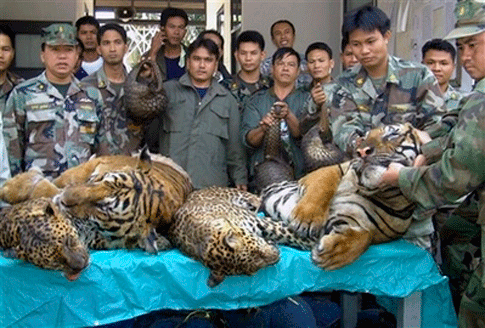We use cookies to make your experience better. To comply with the new e-Privacy directive, we need to ask for your consent to set the cookies. Learn more.
Endangered status

The tiger is designated as endangered on the 2010 World Conservation Union Red List of Threatened Species, with estimates of a total world population of 3200 adults (from an estimated 100,000 at the beginning of the 20th century)[1]. Of the nine tiger species extant at that time, three are now extinct (Balinese tiger, Javan tiger, Caspian tiger)[2]. The two principal threats to tigers are habitat loss and poaching for the illegal medicine trade.
International trade in tiger body parts is banned under the UN Convention on International Trade in Endangered Species (CITES, Appendix 1). Internal trade has been banned under Chinese law since 1993.
Wild tigers are also killed for their decorative skins, teeth and claws and to protect farmed livestock. The black market value of a tiger can be as high as tens of thousands of dollars, providing an enormous incentive for poaching to continue.
China
In 2007 there were an estimated 37 to 50 wild tigers remaining in China, with about 5,000 being raised on farms. There is pressure on the Chinese government from these farms to allow them to use tiger parts to manufacture medicines and there are regular reports of illegal production of tiger bone wine on the farms. Conservationists fear that tiger farming perpetuates and threatens to reignite consumer demand.
In 1993, China banned the domestic trade of tiger bones, and tiger bone was removed from the official traditional medicine pharmacopoeia. Many Chinese medicine practitioners refuse to use medicines that contain tiger parts, preferring alternative remedies. Surveys in 2006 by TRAFFIC, the wildlife trade monitoring network, showed that less than 3 percent of 663 medicine shops and dealers in 26 cities across China claimed to stock tiger bone. However, outside China the situation is less promising. In 1996-7, 43 percent of medicine shops surveyed by TRAFFIC in Chinese communities in North America were still offering tiger bone products for sale.
Tiger populations outside China [3]
Bangladesh: 200-419
Bhutan: 67-81
Cambodia: 30
India: 1411
Indonesia: 441-679
Lao: 30
Malaysia: 300-493
Myanmar: 100-150
Nepal: 121
Russia: 330-371
Thailand: 25-720
Vietnam: 150
Sources
1. World Wildlife Fund, 2010.
2. International Union for Conservation of Nature
3. IUCN Red List
